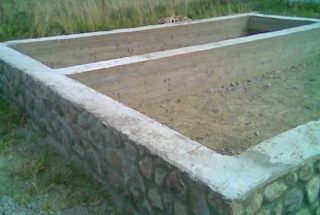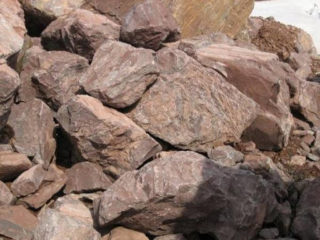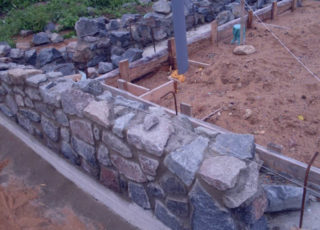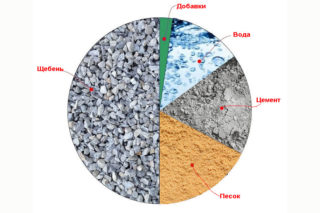The use of rubble stone in the arrangement of foundation foundations is one of the technologies widely used in the construction of private buildings and structures. Booth is a debris of rocks obtained after blasting operations in quarries where minerals are mined. When laying rubble concrete foundations, in addition to these debris, stones formed during the natural weathering of rocks, fragments of bricks, cobblestones, etc., are also used as filler ...
Application area

Foundations with the addition of rubble stones, as a rule, are used in construction:
- garages;
- baths;
- low-rise country houses;
- country houses;
- sheds and other outbuildings.
Most often, stones are used when it is necessary to equip a concrete strip foundation. However, the high strength allows the use of a boot for a columnar or slab foundation, because the process of arrangement is not much different from the technology of pouring a monolithic base.
The rubble concrete foundation can be equipped on various soils, its area of application in comparison with other types of foundation foundations is expanded due to the increased strength, as well as the immunity of rubble stones to frost and groundwater.
The right choice of boot

In order for the rubble concrete foundation to maintain high reliability over many years of the building's operation, be durable and provide good waterproofing, you need to responsibly approach the choice of rubble stones that must meet the following requirements:
- uniform color and geometric dimensions no more than 25x25 cm;
- purity;
- lack of cracks and chips.
The geometric dimensions and shape of the rubble stone are of no small importance when laying the foundation. Very large stones (over 50 kg) can affect the strength characteristics of the base, the presence of a large amount of fine gravel will lead to an increased consumption of the cement-sand mixture. It is recommended to use stones of relatively regular shape with parallel edges.
On the surface of rubble stones, the presence of chips and cracks is unacceptable - this will negatively affect the integrity of the entire foundation structure.
Dirt and the settlement of microflora on rubble stones will reduce adhesion with concrete mortar, therefore, the surface of the stones must be thoroughly cleaned before pouring the foundation.
When selecting, rubble stones are checked for strength: they hit the surface with all their might with a hammer. If a ringing sound is heard and the stone remains intact, it can be used for a rubble concrete foundation. Stones that have crumbled upon impact must not be placed in the foundation. Especially carefully you need to check shell rock and limestone, which do not differ in high strength.
Advantages and disadvantages

Compared to other types of foundations, a crushed concrete foundation has the following advantages:
- durability;
- high compressive strength - the larger the stones, the higher the strength;
- ease of installation;
- low cost - rubble stone is much cheaper than reinforced concrete, and a base made of rubble does not require decorative finishing.
The disadvantages are associated with the construction of the foundation with your own hands: high labor intensity and long construction period.
Installation of rubble concrete foundation
The normative and technical documentation for the arrangement of the rubble concrete foundation base stipulates all the necessary requirements for the materials used (stones, cement, etc.) and for the peculiarities of their combination. Their precise execution guarantees the strength and durability of the future foundation.
Materials and tools

To lay a concrete foundation with your own hands, the developer will need:
- refined river sand of the middle fraction, crushed stone of fine fraction, cement of the M-400 or M-500 grades and water;
- rubble stones;
- fixing jays;
- level or building level;
- shovel;
- a hammer;
- roofing material;
- roulette;
- nails;
- rammer or vibrating plate.

To prepare the mortar, you will also need a concrete mixer and several buckets.
- Prepare the required composition of the mortar as follows:
- Sand and cement are poured into a concrete mixer in a ratio of 3: 1, respectively, which are then thoroughly mixed.
- 5 parts of crushed stone are slowly poured into a concrete mixer mixing dry ingredients and all components are continued to mix until the crushed stone is completely mixed with cement and sand.
- Continuing to mix the dry ingredients, add water in small portions to the concrete mixer until a homogeneous and thick solution is obtained. At the same time, crushed stone should be invisible under the layer of mass.
The consistency of the resulting solution depends on the technology of pouring the foundation and the tool that will be used to compact the foundation (rammer or vibration plate).
Installation
- The first layer of the prepared mortar is poured. Its thickness is 20 cm. Until the solution has set, rubble stones are pressed into it so that half of their surface protrudes outward. The distance between stones should not exceed 5 cm.
- The next layer is poured so that the bottom layer of stones is completely covered, and the liquid layer is half the thickness of the next row of stones.
- The process is repeated up to the top mark, with the last pouring layer to create a smooth mounting surface for the foundation.
Before laying, the surface is moistened with water. Each poured layer of mortar must be pierced in different places with a piece of reinforcement or a wooden stick - this will avoid the presence of air bubbles. If necessary, a reinforcing belt 5 cm thick can be laid on top of the top layer.
In order for the foundation to gain the necessary strength, it must be withstood for at least 28 days. In winter, cover with heat-insulating material, and in summer, water it regularly and protect it from drying out. After the solution has solidified, a leveling screed is performed, the height of which should not be more than 15 cm.









